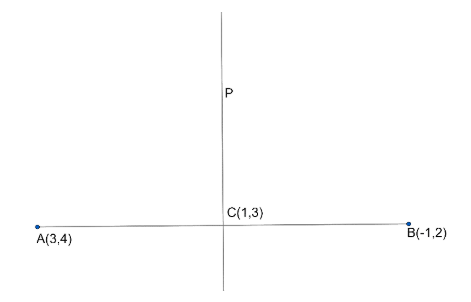Question
Question: Find the equation of the perpendicular bisector of a straight line segment joining the points\((3,4)...
Find the equation of the perpendicular bisector of a straight line segment joining the points(3,4),(−1,2).
Solution
Hint: Name the points and perpendicular bisector. Find the midpoint and slope of (3,4) and (−1,2). Put m1m2=−1 and you will get the slope of the perpendicular bisector. After that use slope point form and you will get the equation.
A perpendicular bisector can be defined as a line segment that intersects another line perpendicularly and divides it into two equal parts.
Two lines are said to be perpendicular to each other when they intersect in such a way that they form 90∘ with each other. And, a bisector divides a line into two equal halves.
Thus, a perpendicular bisector of a line segment AB implies that it intersects AB at 90∘ and cuts it into two halves.
Properties of a Perpendicular Bisector
- It divides AB into two equal halves or bisects it.
- It makes right angles with (or is perpendicular to) AB.
- Every point in the perpendicular bisector is equidistant from point A and B.
While working with practical geometry, you will often find the application of perpendicular bisectors; say when you are asked to draw an isosceles triangle, or when you have to determine the center of a circle, etc.

So in question, there are two points, so let us consider the points as A(3,4) and B(−1,2).
So AB is the segment and we want to find the equation of perpendicular bisector i.e. to find the equation of line P perpendicular to the segment AB.
So as it is a perpendicular bisector, so the point C is the midpoint of the segment AB.
So point C should be (a,b), from which line P passes.
So the point C is the midpoint of the segment AB.
(a,b)=(23+(−1),24+2)=(1,3)
So we get a point C(1,3).
Now we have to find the slope of the line P.
For that, we should find the slope of the segment AB.
So letm1 be the slope of the segment AB.
m1=−1−32−4=−4−2=21
So m1=21,
Now we know if a line is perpendicular to segment, so the product of their slopes is equal to −1.
So let slope of the line P be m2.
So we get,
m1m2=−1
21m2=−1
So we get m2.
m2=−2,
So we have got the slope of a line Pand also know that it is the perpendicular bisector of the line segment AB.
So it passes through the point C.
So now we have a slope and a point so we can use the slope point form to find the equation of the perpendicular bisector.
So general form of slope point form is, if the point is (x1,y1) from which the line passes, and its slope m=−2, then, the line is given by :
y−y1=m(x−x1)
So substituting for m,x1,y1, we get,
y−3=(−2)(x−1)
So simplifying in a simple manner we get,
y−3=−2x+22x+y=5
So we get the equation of perpendicular bisector i.e. line P of the straight line segment joining the points (3,4),(−1,2) is 2x+y=5.
Note: Read the question carefully. Be familiar with the properties. Don’t confuse yourself with m1m2=−1 this one. Also, you should know the general form of slope point form y−y1=m(x−x1). While substituting do not confuse with the points. Also while finding the slope be careful of the substitutions.
